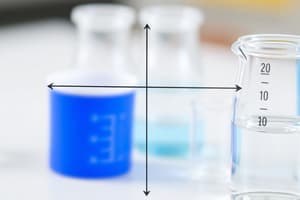Podcast
Questions and Answers
What is the main goal of the design of experiments?
What is the main goal of the design of experiments?
- Ensuring no factors impact the outcome
- Identifying all factors involved
- Predicting outcomes accurately (correct)
- Increasing the number of runs required
Which statistical tool is commonly used to analyze differences between groups in experimental design?
Which statistical tool is commonly used to analyze differences between groups in experimental design?
- Linear Regression
- Chi-Square Test
- ANOVA (correct)
- T-Test
What is the purpose of verification through confirmation experiments in the design of experiments?
What is the purpose of verification through confirmation experiments in the design of experiments?
- To ensure the prediction equations are accurate (correct)
- To eliminate all factors except one
- To avoid analyzing collected data
- To invalidate the initial results
Why is it important to screen a large number of factors down to essential ones in the design of experiments?
Why is it important to screen a large number of factors down to essential ones in the design of experiments?
In experimental design, what are the seven main steps involved in planning?
In experimental design, what are the seven main steps involved in planning?
What is the purpose of calculating the F ratio in ANOVA?
What is the purpose of calculating the F ratio in ANOVA?
What is the purpose of replicating experiments in a two-way ANOVA?
What is the purpose of replicating experiments in a two-way ANOVA?
What is the purpose of the interaction term in ANOVA?
What is the purpose of the interaction term in ANOVA?
What is the main advantage of using fractional factorial experiments over full factorial experiments?
What is the main advantage of using fractional factorial experiments over full factorial experiments?
Flashcards are hidden until you start studying
Study Notes
- Experimental design involves planning a set of experiments or tests on a response variable, where factors or inputs are varied at different settings or levels.
- Properly designed experiments are crucial to extracting meaningful information from collected data.
- The design of experiments aims to determine if any factor or combination of factors has a significant impact on the outcome.
- It can involve predicting outcomes, optimizing processes, and validating results through confirmation experiments.
- Design of experiments has several objectives, including learning efficiently from as few runs as possible and identifying significant factors.
- It helps in screening a large number of factors down to essential ones and modeling processes with prediction equations.
- Seven steps are involved in the design of experiments: defining the project, setting up a cross-functional team, stating objectives, establishing control factors and levels, selecting response variables, choosing the experimental design, and planning the experiment.
- Analyzing the data is crucial in determining optimum levels of factors and predicting performance under those levels.
- Verification through confirmation experiments ensures the validity of predicted outcomes.
- ANOVA (Analysis of Variance) is a statistical tool used to analyze differences between groups, where factors or variables are tested to see if they have a significant impact on the outcome.
- ANOVA involves calculating sum of squares, degrees of freedom, mean squares, F ratio, and p-values to determine the significance of factors.
- Interpreting ANOVA results involves looking at the confidence level based on p-values to conclude if factors have a significant impact or not.
- Two-way ANOVA is used when analyzing the impact of two variables on an outcome, and replication of experiments enhances reliability and repeatability of results.
- Interaction terms in ANOVA account for the joint effect of multiple variables on the outcome, providing a comprehensive analysis of factors' significance.- In experimental design, degrees of freedom between temperature and detergent are calculated as 6, and the total degrees of freedom is 35 for a dataset of 36 data points.
- The optimal combination for best cleanliness is found to be hot water and detergent C based on significant interaction between variables.
- Full factorial experiments involve running all possible combinations of factors and levels, such as conducting all 8 experiments for 3 factors with 2 levels each.
- Conducting a full factorial experiment with 10 factors at 2 levels each would require 1024 experiments, which can be time-consuming and expensive in industries like chemical industry.
- Fractional factorial experiments, popularized by Dr. Taguchi, help reduce the number of experiments needed significantly, from 1024 to just 16 while still providing valuable information and manageability in conducting experiments.
Studying That Suits You
Use AI to generate personalized quizzes and flashcards to suit your learning preferences.




